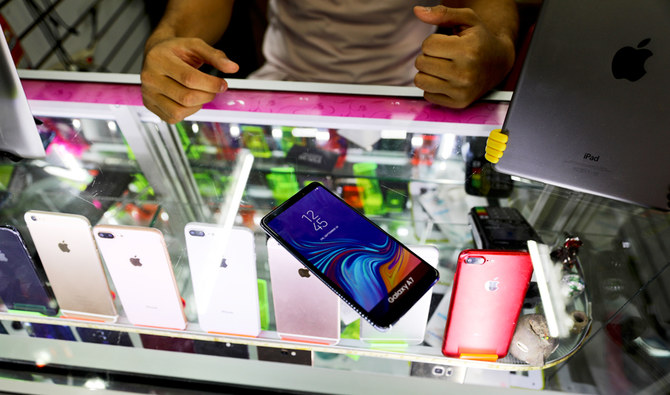MEXICO CITY: Armed robberies have gotten so common aboard buses in Mexico City that commuters have come up with a clever if disheartening solution: Many are buying fake cellphones, to hand over to thieves instead of their real smartphones.
Costing 300 to 500 pesos apiece — the equivalent of $15 to $25 — the “dummies” are sophisticated fakes: They have a startup screen and bodies that are dead ringers for the originals, and inside there is a piece of metal to give the phone the heft of the real article.
That comes in handy when trying to fool trigger-happy bandits who regularly attack the buses, big and small, that ferry people from the poorer outlying suburbs to jobs in the city center.
The scene is repeated over and over again, courtesy of the cameras that many buses now carry that record the assaults, often late at night or in the early morning: Sleepy passengers are seen bouncing along in the jitneys when one or two of the men aboard suddenly pull masks over their faces. One will pull out a gun while his accomplice passes down the aisle, often with his own gun, demanding valuables.
“You’re all screwed now! Don’t move or you’re dead! Cellphones and wallets!” barks a thief in one recent video. Time and again, those who resist or refuse are hit in the head with a pistol, or simply shot and left to bleed on the floor of the bus.
Martha Patricia Rociles Estrada, a schoolteacher from the low-income suburb of Nezahualcoyotl, was robbed herself. Now, she says, most city residents make their daily commutes in fear. “Getting on public transportation is now a risk,” Rociles Estrada said. “You get on, but you never know if you’re going to return.”
“Now you have to be careful to carry money, because if you don’t, the thieves get angry and you run the risk that they’ll shoot you if you’re not carrying money.”
There were an average of 70 reported violent muggings every day in Mexico City in the first four months of 2019. About two-thirds were committed against pedestrians, with the rest split almost evenly between bus passengers and assaults on motorists stopped at lights or caught in traffic jams. Between 2017 and 2018, such assaults rose by about 22 percent.
But when Rociles Estrada was robbed at gunpoint several years ago, most people weren’t carrying costly smartphones around with them.
“They just took whatever I had of value, my change purse, that was all,” she recalled
The advent of smartphones changed all that. Now, many people carry a device worth hundreds of dollars in their pocket, and one that may also hold their bank or credit card information.
That’s where “dummy” vendors like Axel come in. Axel says he sells three or four dummy phones a week out of his stall in a downtown electronics marketplace, next door to a colonial college building that dates to 1767.
Axel, who asked his full name not be used for fear police would accuse him of selling fake merchandise, said all of his customers know they are buying fakes.
“It’s useful for robberies, the large number of muggings happening in Mexico City,” said Axel. “They say ‘hand over your cellphone, give me everything’, and people know now they have to hand over the phone quick, in a matter of seconds, so they hand over these phones and often the thieves don’t realize it.”
But Axel admits the victim would be in trouble if a thief caught them handing over a “dummy” phone.
“Obviously there are problems, because if the criminals search it or find out ... there is going to be a problem.”
Because of that, some try a different strategy, spending a little more to buy a cheap but real second phone.
Gloria, who works at her own stall at another market across the street in a converted art-deco movie house, said the dummy trade started about 14 years ago, but for different reasons: Phone shops would buy dummies for their exhibition cases to protect against another type of crime, the so-called “sledgehammer crews” who can clear out a jewelry or electronics store in seconds by breaking windows.
“Generally, the dummy is for a showcase, for people who sell real cellphones,” Gloria explained. “Dummies have been sold here for about 14 years, for use in showcases, but nowadays people are buying them to protect their own cellphones.”
Gloria sells an iPhone dummy for 300 pesos ($15), that would save a victim the 18,000 pesos ($900) a real iPhone would cost here.
“In most cases, people want to avoid getting their cellphone stolen, but also their data,” says Gloria, who also asked her last name not be used.
The paranoia about assaults and muggings has been amplified by the fact that so many of the robberies are now videotaped by surveillance cameras on public buses. The tapes are often shown on news programs, instilling terror in people.
The government of the eastern borough of Ixtapalpa — one of the city’s biggest and poorest precincts — launched a program this week to have police ride the buses to prevent robberies. But even as the program started up with fanfare and media photo ops, some residents were skeptical.
Oscar Armenda, a transportation worker who was riding a bus in Iztapalapa around midday as police started climbing aboard, said, “This is good in a way, but in a way it’s not.”
“They should do this at the time of day when it’s needed, at night, not now,” Armenda said.
Mexicans buy fake cellphones to hand over in muggings
Mexicans buy fake cellphones to hand over in muggings

- The government of the eastern borough of Ixtapalpa — one of the city’s biggest and poorest precincts — launched a program this week to have police ride the buses to prevent robberies
A 98-year-old in Ukraine walked miles to safety from Russians, with slippers and a cane

- Describing her journey, the nonagenarian said she had fallen twice and was forced to stop to rest at some points, even sleeping along the way before waking up and continuing her journey
KYIV, Ukraine: A 98-year-old woman in Ukraine who escaped Russian-occupied territory by walking almost 10 kilometers (6 miles) alone, wearing a pair of slippers and supported by a cane has been reunited with her family days after they were separated while fleeing to safety.
Lidia Stepanivna Lomikovska and her family decided to leave the frontline town of Ocheretyne, in the eastern Donetsk region, last week after Russian troops entered it and fighting intensified.
Russians have been advancing in the area, pounding Kyiv’s depleted, ammunition-deprived forces with artillery, drones and bombs.
“I woke up surrounded by shooting all around — so scary,” Lomikovska said in a video interview posted by the National Police of Donetsk region.
In the chaos of the departure, Lomikovska became separated from her son and two daughters-in-law, including one, Olha Lomikovska, injured by shrapnel days earlier. The younger family members took to back routes, but Lydia wanted to stay on the main road.
With a cane in one hand and steadying herself using a splintered piece of wood in the other, the pensioner walked all day without food and water to reach Ukrainian lines.
Describing her journey, the nonagenarian said she had fallen twice and was forced to stop to rest at some points, even sleeping along the way before waking up and continuing her journey.
“Once I lost balance and fell into weeds. I fell asleep … a little, and continued walking. And then, for the second time, again, I fell. But then I got up and thought to myself: “I need to keep walking, bit by bit,’” Lomikovska said.
Pavlo Diachenko, acting spokesman for the National Police of Ukraine in the Donetsk region, said Lomikovska was saved when Ukrainian soldiers spotted her walking along the road in the evening. They handed her over to the “White Angels,” a police group that evacuates citizens living on the front line, who then took her to a shelter for evacuees and contacted her relatives.
“I survived that war,’ she said referring to World War II. “I had to go through this war too, and in the end, I am left with nothing.
“That war wasn’t like this one. I saw that war. Not a single house burned down. But now – everything is on fire,” she said to her rescuer.
In the latest twist to the story, the chief executive of one of Ukraine’s largest banks announced on his Telegram channel Tuesday that the bank would purchase a house for the pensioner.
“Monobank will buy Lydia Stepanivna a house and she will surely live in it until the moment when this abomination disappears from our land,” Oleh Horokhovskyi said.
Amazon Purr-rime: Cat accidentally shipped to online retailer

- Galena was found safe by a warehouse worker at an Amazon center after vanishing from her home in Utah
LOS ANGELES: A curious cat that sneaked into an open box was shipped across the United States to an Amazon warehouse after its unknowing owners sealed it inside.
Carrie Clark’s pet, Galena, vanished from her Utah home on April 10, sparking a furious search that involved plastering “missing” posters around the neighborhood.
But a week later, a vet hundreds of miles (kilometers) away in Los Angeles got in touch to say the cat had been discovered in a box — alongside several pairs of boots — by a warehouse worker at an Amazon center.
“I ran to tell my husband that Galena was found and we broke down upon realizing that she must have jumped into an oversized box that we shipped out the previous Wednesday,” Clark told KSL TV in Salt Lake City.
“The box was a ‘try before you buy,’ and filled with steel-toed work boots.”
Clark and her husband jetted to Los Angeles, where they discovered Amazon employee Brandy Hunter had rescued Galena — a little hungry and thirsty after six days in a cardboard box, but otherwise unharmed.
“I could tell she belonged to someone by the way she was behaving,” said Hunter, according to Amazon.
“I took her home that night and went to the vet the next day to have her checked for a microchip, and the rest is history.”
What did people eat before agriculture? New study offers insight

- Analysis of forms — or isotopes — of elements including carbon, nitrogen, zinc, sulfur and strontium in these remains indicated the type and amount of plants and meat they ate
WASHINGTON: The advent of agriculture roughly 11,500 years ago in the Middle East was a milestone for humankind — a revolution in diet and lifestyle that moved beyond the way hunter-gatherers had existed since Homo sapiens arose more than 300,000 years ago in Africa.
While the scarcity of well-preserved human remains from the period preceding this turning point has made the diet of pre-agricultural people a bit of a mystery, new research is now providing insight into this question. Scientists reconstructed the dietary practices of one such culture from North Africa, surprisingly documenting a heavily plant-based diet.
The researchers examined chemical signatures in bones and teeth from the remains of seven people, as well as various isolated teeth, from about 15,000 years ago found in a cave outside the village of Taforalt in northeastern Morocco. The people were part of what is called the Iberomaurusian culture.
Analysis of forms — or isotopes — of elements including carbon, nitrogen, zinc, sulfur and strontium in these remains indicated the type and amount of plants and meat they ate. Found at the site were remains from different edible wild plants including sweet acorns, pine nuts, pistachio, oats and legumes called pulses. The main prey, based on bones discovered at the cave, was a species called Barbary sheep.
“The prevailing notion has been that hunter-gatherers’ diets were primarily composed of animal proteins. However, the evidence from Taforalt demonstrates that plants constituted a big part of the hunter-gatherers’ menu,” said Zineb Moubtahij, a doctoral student in archaeology at the Max Planck Institute for Evolutionary Anthropology in Germany and lead author of the study published on Monday in the journal Nature Ecology & Evolution.
“It is important as it suggests that possibly several populations in the world already started to include substantial amount of plants in their diet” in the period before agriculture was developed, added archeogeochemist and study co-author Klervia Jaouen of the French research agency CNRS.
The Iberomaurusians were hunter-gatherers who inhabited parts of Morocco and Libya from around 25,000 to 11,000 years ago. Evidence indicates the cave served as a living space and burial site.
These people used the cave for significant portions of each year, suggesting a lifestyle more sedentary than simply roaming the landscape searching for resources, the researchers said. They exploited wild plants that ripened at different seasons of the year, while their dental cavities illustrated a reliance on starchy botanical species.
Edible plants may have been stored by the hunter-gatherers year-round to guard against seasonal shortages of prey and ensure a regular food supply, the researchers said.
These people ate only wild plants, the researchers found. The Iberomaurusians never developed agriculture, which came relatively late to North Africa.
“Interestingly, our findings showed minimal evidence of seafood or freshwater food consumption among these ancient groups. Additionally, it seems that these humans may have introduced wild plants into the diets of their infants at an earlier stage than previously believed,” Moubtahij said.
“Specifically, we focused on the transition from breastfeeding to solid foods in infants. Breast milk has a unique isotopic signature, distinct from the isotopic composition of solid foods typically consumed by adults.”
Two infants were among the seven people whose remains were studied. By comparing the chemical composition of an infant’s tooth, formed during the breastfeeding period, with the composition of bone tissue, which reflects the diet shortly before death, the researchers discerned changes in the baby’s diet over time. The evidence indicated the introduction of solid foods at around the age of 12 months, with babies weaned earlier than expected for a pre-agricultural society.
North Africa is a key region for studying Homo sapiens evolution and dispersal out of Africa.
“Understanding why some hunter-gatherer groups transitioned to agriculture while others did not can provide valuable insights into the drivers of agricultural innovation and the factors that influenced human societies’ decisions to adopt new subsistence strategies,” Moubtahij said.
Palestinian prisoner in Israel wins top fiction prize

- The mask in the novel’s title refers to the blue identity card that Nur, an archaeologist living in a refugee camp in Ramallah, finds in the pocket of an old coat belonging to an Israeli
ABU DHABI: Palestinian writer Basim Khandaqji, jailed 20 years ago in Israel, won a prestigious prize for Arabic fiction on Sunday for his novel “A Mask, the Color of the Sky.”
The award of the 2024 International Prize for Arabic Fiction was announced at a ceremony in Abu Dhabi.
The prize was accepted on Khandaqji’s behalf by Rana Idriss, owner of Dar Al-Adab, the book’s Lebanon-based publisher.
Khandaqji was born in the Israeli-occupied West Bank city of Nablus in 1983, and wrote short stories until his arrest in 2004 at the age of 21.
He was convicted and jailed on charges relating to a deadly bombing in Tel Aviv, and completed his university education from inside jail via the Internet.
The mask in the novel’s title refers to the blue identity card that Nur, an archaeologist living in a refugee camp in Ramallah, finds in the pocket of an old coat belonging to an Israeli.
Khandaqji’s book was chosen from 133 works submitted to the competition.
Nabil Suleiman, who chaired the jury, said the novel “dissects a complex, bitter reality of family fragmentation, displacement, genocide, and racism.”
Since being jailed Khandaqji has written poetry collections including “Rituals of the First Time” and “The Breath of a Nocturnal Poem.”
He has also written three earlier novels.
Mexican doctor claims victory in $28 Cartier earrings battle

MEXICO CITY: A Mexican man has claimed a victory over French luxury brand Cartier, saying an error allowed him to buy two pairs of earrings for $28 that were supposed to cost nearly $28,000.
After a four-month struggle, doctor Rogelio Villarreal said he had finally received the jewelry, which he accused the company of refusing to deliver after his online purchase in December.
According to Villarreal, he came across the low-priced earrings while browsing Instagram.
“I swear I broke out in a cold sweat,” he wrote on the social media platform X.
Cartier declined to recognize the purchase and offered Villarreal a refund, as well as a bottle of champagne and a passport holder as compensation, according to a company letter shared by the doctor.
But Villarreal refused and decided to take the case to Mexico’s consumer protection agency, which ruled in favor of the doctor.
Cartier accepted the decision, Villarreal announced.
“War is over. Cartier is complying,” he wrote.




















